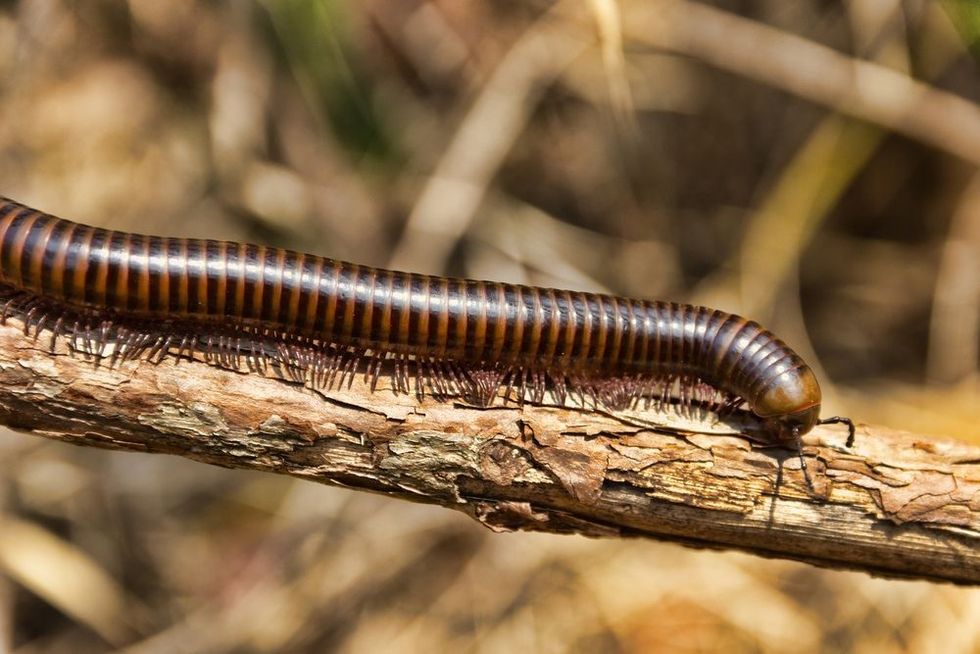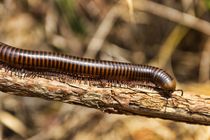Millipedes are tiny arthropods that have two legs per body segment.
While their name 'millipedes' denotes 1,000 legs, in reality, they do not possess so many legs. Unlike centipedes, they generally have between 80-100 legs in total.
Millipedes possess a fragmented exterior, little antennas, and outnumbered legs. Their body sections have four legs that stand out from the edges of their figure.
The sections that possess two pairs of legs are known as diplosomites. Centipedes and millipedes share some drastic similarities. From causing allergies from their poisonous venom to both being invertebrates, there are many!
Besides, they belong to the family of arthropods and the largest species in the Animal Kingdom, including insects, lobsters, crabs, and spiders. Millipedes and centipedes possess one pair of antennae, many pairs of legs per body segment, and breathe through tiny holes amidst their bodies.
If you found this article interesting, why not also read about facts about how big an iguana gets and facts about owls?
How To Handle Millipedes If They Attack Humans
Typically, millipedes are not poisonous to humans. Although a millipede doesn’t bite you directly, the poisonous fluid within these arthropods can cause some irritable symptoms on your skin if you come into contact with them.
Still, as with handling any animals, it’s important to take extra care no matter what. However, the chances of allergic reactions or irritation are possible, yes, if you come into contact with a millipede that secretes poisonous fluid from its glands that works as a natural defense mechanism.
Millipedes and centipedes aren’t aggressive. They don’t tend to attack humans.
Rather, they feed decomposing vegetative matter and other organic stuff in which they eat food from small plants and other leaves. These bugs have brown skin which helps them to easily camouflage on any stem of a plant.
Since both of these bugs are not capable enough to move fast along with their inability to bite or sting, a millipedes' main way to defend is by winding itself into a rigid coil. In this way, they can protect their sensitive legs inside their protected layer.
Many species of Millipedes tend to secrete various foul-smelling toxic liquid secretions from microscopic pores called ozopores. These glands are amidst the bodies of these bugs as a backup form of defense. Some of these substances have decaying properties.
These millipedes have the capability to decay the outer covering of ants and other insect predators as well. Moreover, they can damage the skin and eyes of larger predators.
Primates such as capuchin monkeys and lemurs were seen deliberately irritating millipedes. It is because they rub the fluid on themselves to repulse mosquitoes. Some of these defensive compounds also indicate antifungal activities.
How dangerous are African millipedes?
Millipedes can only kill you if you consume these creatures. The venom of centipedes is more toxic than millipedes. If a centipede stings, its toxic fluid can cause a severe allergic reaction, irritation, agony, redness, and swelling at the site of injury.
Mostly, symptoms can go away within a couple of days if you can wash the threatened area and spray some anti-allergic medicines for instant treatment. In some cases, more serious problems can occur.
These can include infection and the breakdown of tissue and skin at the site. On the contrary, African millipedes do not sting or bite like centipedes. Some large millipede species can spray these toxins almost 3.2 ft (1 m).
Coming into contact with these secretions may cause allergies in some people. Millipede fluid contains a diverse combination of toxins.
If you think millipedes bite, this is wrong, it doesn't really bite. Rather, they spray a fluid that disturbs the skin, which can cause a feeling of itching and burning.
Millipedes and centipedes affect our skin as well as other parts like our hands and legs. The defensive mechanisms of a millipede set them apart from the rest, although a millipede cannot kill a human being.
However, it is always preferable to go for prompt treatment as soon as the reaction starts to show on your body. These creatures are more common in places with higher humidity. Unlike centipedes, millipedes tend to appear more frequently in houses.
To get rid of them, pest control services are there to take care of your health. They wash away these creatures from your house in an instance.
Which are more dangerous- centipedes or millipedes?

Unlike centipedes, millipedes are not poisonous. However, many species possess certain glands that are capable of secreting a toxic liquid. As a result, it will lead to some allergic reactions. If a millipede enters your house, it is not advisable to handle these insects with your bare hands.
Persons handling a millipede may also get a strange odor on their hands. Some of the most common problems faced are intense agony, redness, skin discoloration, pain in the cornea area, inflammation, and many more.
While you are facing intense pain and irritation, it means the toxins have penetrated inside your body. When the millipedes secrete the fluid, it has some acidic elements which might lead to extreme irritation on your epidermal area. Typically, the irritations are localized to the region affected.
Secondly, redness is another side effect that you can face. It is the most common indication that a millipede has sprayed you using its toxic fluid. Thirdly, if the toxins of these insects get inside your body, it causes inflammation. As a result, this leads to allergies where your immune system fights for infections and other ailments.
As well as this, these toxins will lead to the discoloration of your epidermal area. Since it is a chronic effect, it takes time to cope with the defensive fluid of the millipede by the immune system.
This mainly happens due to the wearing of your skin done by the caustic component of the secretion. As a result, there is an increasing expiry of the epidermal cells.
Last but not least, the pain which happens is in the cornea region. In this disease, There are certain symptoms that This is a serious manifestation that signifies the spraying of the toxic fluid to your eyes.
This will lead to Conjunctivitis owing to which you will suffer from intense irritations and last but not least, this will lead to inflammation of your eyes. Although this fluid does not hamper your life you should be precautious enough to not mess with any millipedes.
Precautions To Be Taken If You Touch A Millipede
Yes, it is harmful to touch using your bare hands. Unlike centipedes, millipedes are not poisonous. If a millipede enters your house, it is not advisable to handle these insects with your bare hands. People handling a millipede may also get a strange odor on their hands.
Millipedes are pests that can enter your house anytime. To control their threat during the summer season, you need to use pest control. This includes sealing around doors, windows, and many other areas. Moreover, it is also about reducing moist places where you can be threatened by millipedes during the summer season.
However, these services can turn out to be expensive if you call a foundation that uses high-end technologies. To manage their threat during hot weather, you need to implement some pest management.
There are certain precautions that need to be taken if you accidentally touch a millipede. However, if you have been sprayed with the fluid, kindly consider the following ways.
First of all, wash the infected area with soap and water instantly. This should be implemented promptly once you got sprayed. You need to apply lots of water to your infected area at first.
Thereafter, apply soap to completely clean the section. If it seems to hurt, you can put an ice cube on the infected area to give you an instant cooling effect.
Secondly, you can use papain. It is an enzyme secreted from papaya. Papain can turn out to be very effective if you have some trouble with the toxic liquid.
This occurs due to the breakdown of enzymes present in this toxic fluid. To stop any kind of trouble, the reaction is neutralized by the effects of the toxic liquid. Nonetheless, papain should be used not to replace the regular maintenance of the infected area.
Lastly, you should cover the infected region with a neat and clean wrap of bandage. However, you should not let your affected area come in contact with any other form of pollutants or infections. This can be done by using fresh bandages.
Here at Kidadl, we have carefully created lots of interesting family-friendly facts for everyone to enjoy! If you liked our suggestions for are millipedes dangerous then why not take a look at are groundhogs dangerous, or why do dogs cough.









